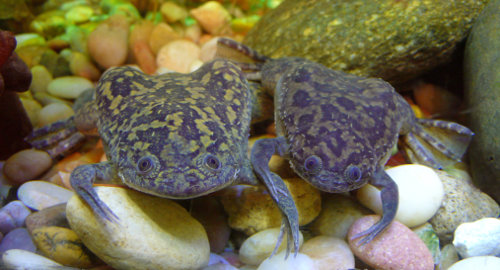Xénope commun : Différence entre versions
m (A déprotégé « Xénope commun ») |
|||
| Ligne 1 : | Ligne 1 : | ||
[[Category:Amphibiens]] | [[Category:Amphibiens]] | ||
| + | |||
| + | [[Image:Xenopus_laevis_pair.JPG]] | ||
| + | |||
| + | Xénope commun Xenopus laevis | ||
====== Etymologie ====== | ====== Etymologie ====== | ||
| − | *'''Nom latin''' : ''Xenopus laevis'' | + | *'''Nom latin''' : ''Xenopus laevis'' |
| − | *'''Noms anglais''' : Platanna, Common Clawed Toad, Clawed Frog, Clawed Toad, Common Clawed Frog, African Clawed Toad, Common Platanna, African Clawed Frog, Smooth Clawed Frog, Upland Clawed Frog | + | *'''Noms anglais''' : Platanna, Common Clawed Toad, Clawed Frog, Clawed Toad, Common Clawed Frog, African Clawed Toad, Common Platanna, African Clawed Frog, Smooth Clawed Frog, Upland Clawed Frog |
*'''Famille''' : '''Pipidae''' | *'''Famille''' : '''Pipidae''' | ||
====== Description ====== | ====== Description ====== | ||
| + | |||
-- | -- | ||
| + | |||
====== Distribution ====== | ====== Distribution ====== | ||
| − | *'''Espèce originaire d'Afrique du sud''' : Angola (Angola); Botswana; Cameroon; Central African Republic; Congo, The Democratic Republic of the; Gabon; Lesotho; Malawi; Mozambique; Namibia; Nigeria; South Africa; South Sudan; Swaziland; Zambia; Zimbabwe | + | |
| + | *'''Espèce originaire d'Afrique du sud''' : Angola (Angola); Botswana; Cameroon; Central African Republic; Congo, The Democratic Republic of the; Gabon; Lesotho; Malawi; Mozambique; Namibia; Nigeria; South Africa; South Sudan; Swaziland; Zambia; Zimbabwe | ||
*'''Introduit''' au Chili, en France, en Indonésie, en Sicile en Italie, au Mexique, au Portugal, au Royaume-Uni et aux États-Unis. | *'''Introduit''' au Chili, en France, en Indonésie, en Sicile en Italie, au Mexique, au Portugal, au Royaume-Uni et aux États-Unis. | ||
| + | |||
====== Habitat ====== | ====== Habitat ====== | ||
| − | *Eaux douces et habitats variés, mais évite les grandes rivières. Les plus grandes densités se trouvent dans les eaux eutrophes. | + | |
| + | *Eaux douces et habitats variés, mais évite les grandes rivières. Les plus grandes densités se trouvent dans les eaux eutrophes. | ||
*Espèce opportuniste. | *Espèce opportuniste. | ||
| + | |||
====== Biologie, reproduction ====== | ====== Biologie, reproduction ====== | ||
| − | *Reproduction dans l'eau stagnante. | + | |
| − | *Gros potentiel de reproduction. | + | *Reproduction dans l'eau stagnante. |
| − | *'''Migration''' : peut migrer en grands nombre. | + | *Gros potentiel de reproduction. |
| − | ====== Remarque ====== | + | *'''Migration''' : peut migrer en grands nombre. |
| − | *Cette espèce est souvent élevée en laboratoire comme organisme modèle. | + | |
| + | ====== Remarque ====== | ||
| + | |||
| + | *Cette espèce est souvent élevée en laboratoire comme organisme modèle. | ||
| + | |||
====== Nourriture ====== | ====== Nourriture ====== | ||
| + | |||
*Petits invertébrés. | *Petits invertébrés. | ||
| + | |||
====== Statut ====== | ====== Statut ====== | ||
| − | *<span style="color: rgb(255, 0, 0);">'''Espèce introduite - non protégée'''</span> | + | |
| + | *<span style="color: rgb(255, 0, 0);">'''Espèce introduite - non protégée'''</span> | ||
| + | |||
====== Bibliographie ====== | ====== Bibliographie ====== | ||
| + | |||
*'''Faune de France '''(reptiles et amphibiens)- (1946), Angel F. Eds Lechevalier, Paris. (épuisé) | *'''Faune de France '''(reptiles et amphibiens)- (1946), Angel F. Eds Lechevalier, Paris. (épuisé) | ||
*'''Le guide herpéto'''- (2004), Arnold N. & Ovenden D. Eds Delachaux & Niestlé. <br> | *'''Le guide herpéto'''- (2004), Arnold N. & Ovenden D. Eds Delachaux & Niestlé. <br> | ||
Version du 11 août 2015 à 08:34
Xénope commun Xenopus laevis
Sommaire
Etymologie
- Nom latin : Xenopus laevis
- Noms anglais : Platanna, Common Clawed Toad, Clawed Frog, Clawed Toad, Common Clawed Frog, African Clawed Toad, Common Platanna, African Clawed Frog, Smooth Clawed Frog, Upland Clawed Frog
- Famille : Pipidae
Description
--
Distribution
- Espèce originaire d'Afrique du sud : Angola (Angola); Botswana; Cameroon; Central African Republic; Congo, The Democratic Republic of the; Gabon; Lesotho; Malawi; Mozambique; Namibia; Nigeria; South Africa; South Sudan; Swaziland; Zambia; Zimbabwe
- Introduit au Chili, en France, en Indonésie, en Sicile en Italie, au Mexique, au Portugal, au Royaume-Uni et aux États-Unis.
Habitat
- Eaux douces et habitats variés, mais évite les grandes rivières. Les plus grandes densités se trouvent dans les eaux eutrophes.
- Espèce opportuniste.
Biologie, reproduction
- Reproduction dans l'eau stagnante.
- Gros potentiel de reproduction.
- Migration : peut migrer en grands nombre.
Remarque
- Cette espèce est souvent élevée en laboratoire comme organisme modèle.
Nourriture
- Petits invertébrés.
Statut
- Espèce introduite - non protégée
Bibliographie
- Faune de France (reptiles et amphibiens)- (1946), Angel F. Eds Lechevalier, Paris. (épuisé)
- Le guide herpéto- (2004), Arnold N. & Ovenden D. Eds Delachaux & Niestlé.
- Les amphibiens de France, Belgique et Luxembourg (+ CD audio) – (2003), Duguet R. & Melki F. (direction scientifique), collectif de l’ACEMAV. Collection Parthénope. Eds Biotope, Mèze.
- Amphibiens et reptiles – (1963), Dotrens E., Eds Delachaux & Niestlé. (épuisé)
- Traité de zoologie Tome XIV, Amphibiens : anatomie, systématique, biologie – (1997) volumes 1a et 1b, Grassé P-P. & Delsol M. Masson (Dunod éditeur).
- Guide des amphibiens et reptiles d’Europe – (2002), Matz G. & Weber D. 2e edition. Eds Delachaux & Niestlé.
- Identifier les œufs et les larves des amphibiens de France – (2004), collection Techniques et Pratiques. Miaud C. & Muratet J. Eds de l’INRA.
- Guide des amphibiens d’Europe, biologie, identification, répartition (+CD audio)- (2003), Nöllert A. & C. Eds Delachaux & Niestlé.
